Sphinx drupiferarum, the Wild Cherry Sphinx
Sphinx drupiferarum
Sfinksmmdroo-pih-fur-AIR-uhm
J. E. Smith, 1797
Wild Cherry Sphinx
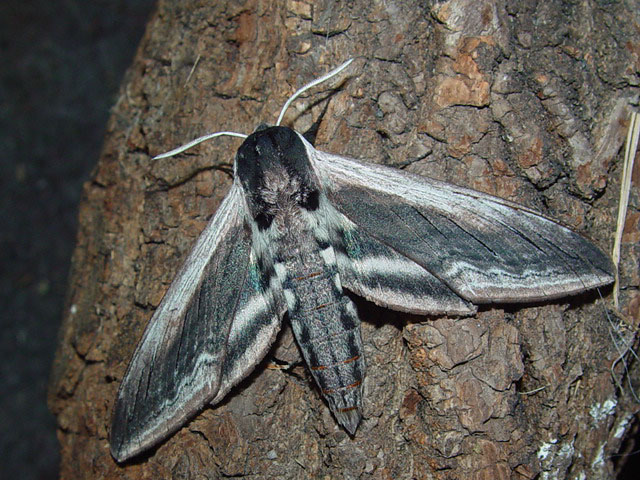
Sphinx drupiferarum, June 29, 2005, Peterborough, Ontario,
courtesy of Tim Dyson.
This site has been created by
Bill Oehlke at
oehlkew@islandtelecom.com
Comments, suggestions and/or additional information are welcomed by
Bill.
TAXONOMY:
Family: Sphingidae, Latreille, 1802
Subfamily: Sphinginae, Latreille, 1802
Tribe: Sphingini, Latreille, 1802
Genus: Sphinx Linnaeus, 1758
Species: drupiferarum J. E. Smith, 1797........
|
MIDI MUSIC
......It's a Wonderful World......
copyright C. Odenkirk
ON.OFF
<bgsound src="world.mid" LOOP=FOREVER>
|
DISTRIBUTION:Sphinx drupiferarum,
the Wild Cherry Sphinx (Wingspan 75 - 115 mm; tongue length 52+-11 mm),
is distributed throughout North America from southern Canada to
northern Florida.
In the last five years on Prince Edward Island, I have only come
across a few males at lights; I have yet to see a live female here. Subsequently I have taken females at lights in
Montague, PEI, and in Malay Falls, Nova Scotia.
Sphinx drupiferarum, Peterborough, Ontario, June 8-9, courtesy of
Tim Dyson.
Forewings, long and slender, are held close to the body when the moth is at rest. | 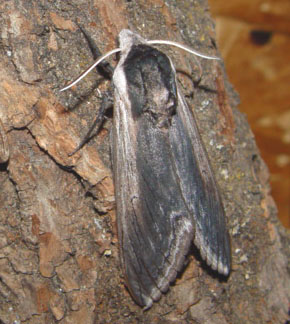 |
The forewing is dull slate grey with considerable light grey scaling in a broad band along the costa about 3/4 of distance from body toward
the apex. Median lines are black and thin. There is a wavy, diffuse dark subterminal line, inwardly bordered by white, and a whitish bar in terminal area,
paralleling outer margin.
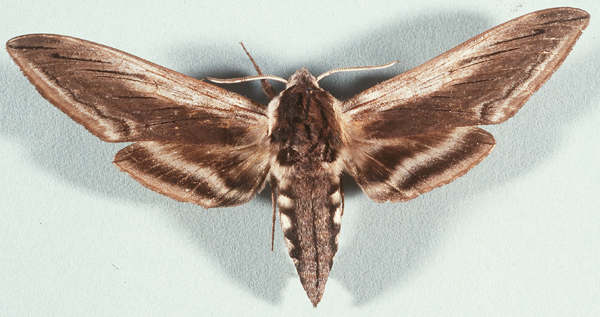
Sphinx drupiferarum courtesy Royal British Columbia Museum
FLIGHT TIMES:
In Canada, Sphinx drupiferarum is single-brooded with
most adults (wingspan 75-115 mm) on the wing in June and July. In New Jersey and states of that
latitiude, drupiferarum is double-brooded.
ECLOSION:Wild cherry Sphinx pupae either wiggle to the
surface from subterranean chambers just prior to eclosion, or
the fresh emergent moths climb from the underground chamber
through the entry tunnel to the surface to
inflate their wings.
Tim Dyson of Peterborough, Ontario, has doen a great job of photographing
both dorsal and ventral surfaces of the many Sphingidae that fly in his
area. | 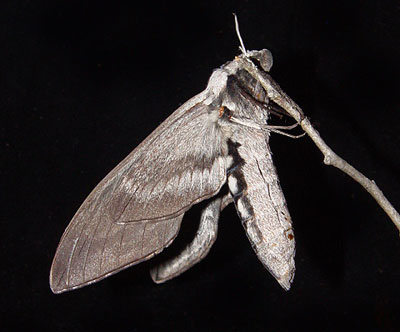 |
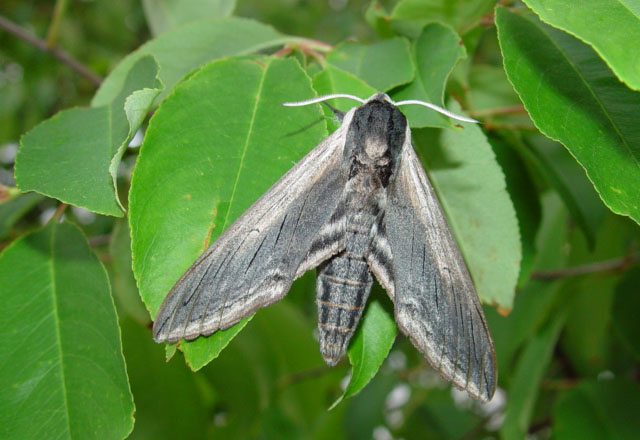
Sphinx drupiferarum on cherry, June 9, 2005, Peterborough,
Ontario, courtesy of Tim Dyson.
Visit Sphinx drupiferarum
adult moth and fifth instar larva, Wisconsin, courtesy of
Janice Stiefel.
Visit Sphinx drupiferarum, Spokane, Spokane County, eastern Washington,
June 12, 2010, courtesy of Erin Parker.
SCENTING AND MATING:
Sphinx drupiferarum females call in males with a pheromone released from a scent gland
at the posterior tip of the abdomen.
EGGS, LARVAE, PUPAE:
Sphinx drupiferarum larvae
hide in the day and feed primarily on cherry, plum, and apple at
night.
Larvae have been found on Amelanchier nantuckensis
in Massachusetts and have been reared to pupation in Michigan on
Prunus serotina from eggs readily oviposited by a
female.
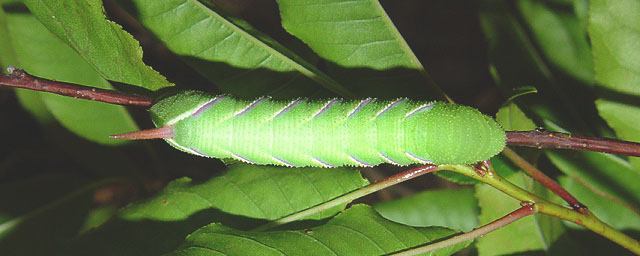
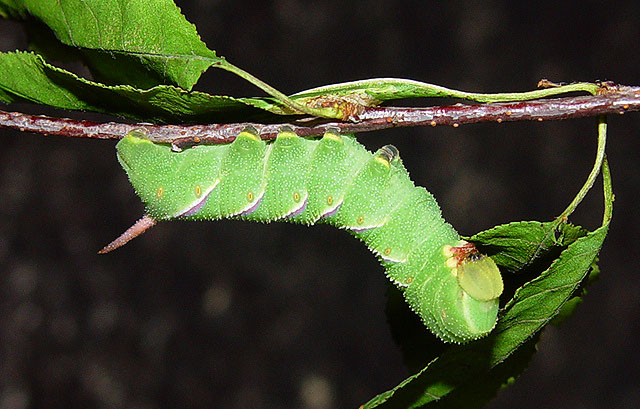
Sphinx drupiferarum, Peterborough, Ontario, July 25, 2005,
courtesy of Tim Dyson.
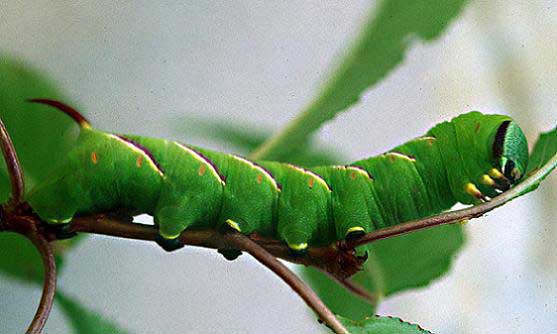
Sphinx drupiferarum fifth instar, Gibraltar, Door County, Wisconsin,
August 4, 2002, Gibraltar, Door County, Wisconsin,
courtesy of Janice Stiefel.
Many thanks to Zana Goulding who provides the following beautiful images of another Sphinx drupiferarum larva from Spokane County, Washington.
Note the yellowish "leggings" on the abdominal feet and the absence of black spots at the apex of the head. In a very similar western species,
Sphinx perelegans, the leggings are a purplish-lilac, and there are two black spots, often hidden by a thoracic shield, at the apex of the head.
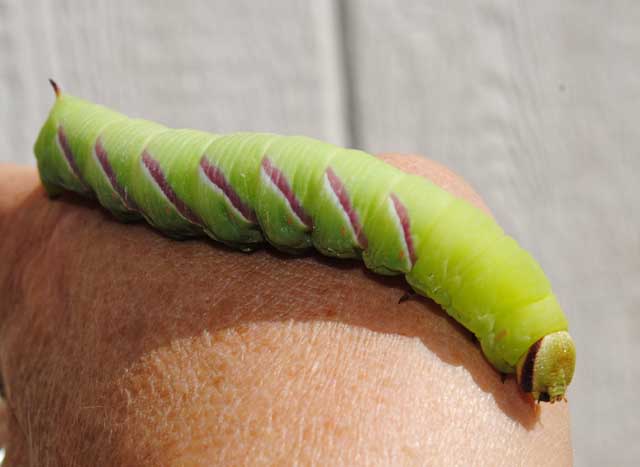
Sphinx drupiferarum fifth instar, Spokane, Spokane County, Washington,
September 5, 2012, courtesy of Zana Goulding.
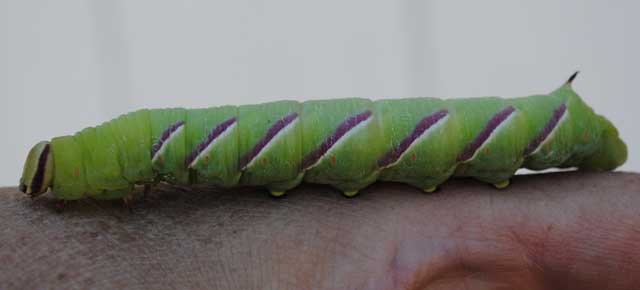
Sphinx drupiferarum fifth instar, Spokane, Spokane County, Washington,
September 5, 2012, courtesy of Zana Goulding.
At maturity, larvae leave the host plant and excavate subterranean
chambers in which to pupate. A mixture of sand and soil and peat
moss, etc., can be prepared for the larvae or they can more simply be
placed in a plastic chamber with some loose paper towels. Larvae
will crawl under the towels and pupate without soil.
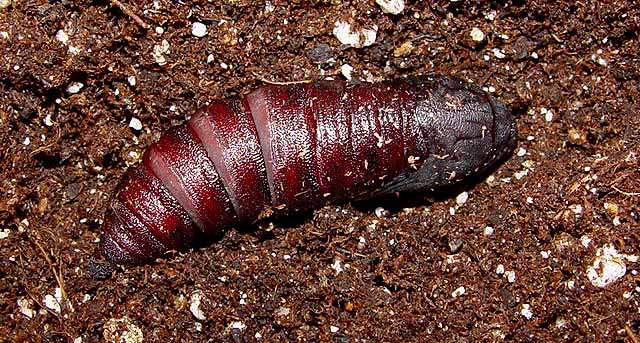
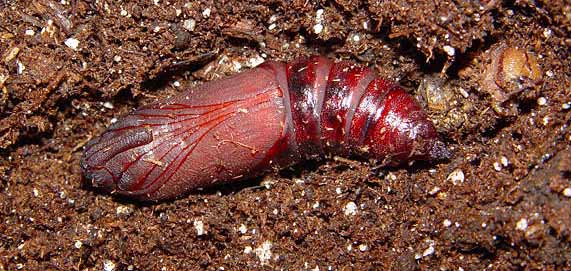
Sphinx drupiferarum, pupae, Peterborough, Ontario,
courtesy of Tim Dyson.
The pronunciation of scientific names is
troublesome for many. The "suggestion" at the top of the page is
merely a suggestion. It is based on commonly
accepted English pronunciation of Greek names and/or some
fairly well accepted "rules" for latinized scientific names.
The suggested pronunciations, on this page and on other pages,
are primarily put forward to assist those who hear with internal
ears as they read.
There are many collectors from different countries whose
intonations and accents would be different.
In ancient Greek mythology the Sphinx was a unique creature with the
body of a lion, the wings of an eagle, and the head and breast of a
woman. It was vicious and single-minded.
The Sphinx sat on a high rock by a road near Thebes and posed a
riddle to all who wished to pass. The Sphinx strangled all who
could not answer its riddle.
"The name "Sphinx" derives from the Greek word
"sphingo," to strangle, or "sphingein," to bind tight, based on
the Sphinx's habit of strangling its victims. The name was
subsequently applied to the Egyptian and other arabic sphinxes
because of their physical similarity to descriptions of the mythical
Greek Sphinx."
Sphingidae larvae often strike a pose similar to that ascribed to
the "Sphinx", so possibly that has to do with the choice of the
genus name.
The species name "drupiferarum" is
possibly from the Greek, 'drupifera' meaning bearing drupes,
referring to plants with fleshy fruit, like cherries or plums, the
larval hosts of this species.
Return to Sphingidae Index
Return to Sphingini Tribe
Enjoy some of nature's wonderments, giant silk moth cocoons.
These cocoons are for sale winter and fall. Beautiful Saturniidae moths will emerge the following spring and summer.
Read Actias luna rearing article. Additional online help available.
Use your browser "Back" button to return to the previous page.
This page is brought to you by
Bill Oehlke and the
WLSS. Pages are on space rented from Bizland. If you would like
to become a "Patron of the Sphingidae Site", contact Bill.
Please send sightings/images to Bill. I will do my best to respond to
requests for identification help.
 | 
Show appreciation for this site by clicking on flashing butterfly to the left.
The link will take you to a page with links to many insect sites. |













